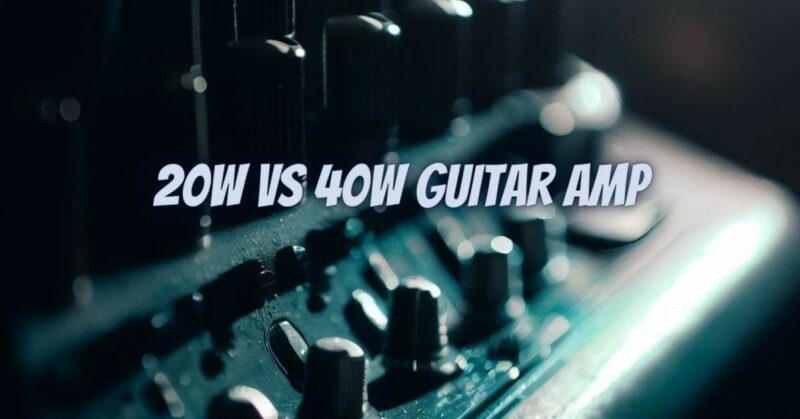Choosing the right guitar amplifier is a crucial decision for any guitarist looking to craft their desired sound. Among the various options available, two common choices are 20W and 40W guitar amplifiers. In this article, we will explore the differences between these two wattage options, delving into their tonal characteristics, volume capabilities, and intended uses to help you make an informed choice for your musical needs.
1. Wattage and Volume
The most obvious distinction between 20W and 40W guitar amplifiers is their wattage rating, which significantly affects the volume levels they can produce.
- 20W Guitar Amps: A 20W amplifier provides enough power for practicing at home, small gigs, and studio recording. These amplifiers typically produce a balanced tone at lower volumes, making them ideal for bedroom practice and intimate performances. They can achieve tube saturation and distortion at more manageable levels, allowing for a rich tone without excessive volume.
- 40W Guitar Amps: A 40W amplifier offers greater headroom and volume potential. These amps are suitable for larger gigs and venues where you need to cut through the mix. They can deliver cleaner tones at higher volumes and provide ample clean headroom for pedals and effects. In addition, 40W amps tend to handle more wattage, allowing for more robust and controlled distortion at higher volumes.
2. Tonal Characteristics
The wattage of a guitar amplifier can influence its tonal characteristics, including the level of saturation and distortion, as well as the dynamics of the sound.
- 20W Guitar Amps: Due to their lower wattage, 20W amplifiers tend to saturate and distort more quickly, especially when pushed to their limits. This can result in a warm, compressed, and vintage-like overdrive. Guitarists who prefer blues, classic rock, or indie genres often appreciate the earlier breakup of 20W amps, which provides a classic, “crunchy” sound.
- 40W Guitar Amps: With their higher wattage, 40W amplifiers typically stay cleaner at higher volumes. This cleaner headroom can be advantageous for jazz, country, and genres where clean tones are a priority. However, 40W amps can also deliver powerful and controlled distortion when needed, making them versatile for various styles, including hard rock and metal.
3. Portability and Practicality
Consider the practical aspects of your amplifier choice, such as portability and the size of the venues you’ll be playing in.
- 20W Guitar Amps: These amplifiers are generally more portable and easier to transport due to their smaller size and lower weight. They are perfect for musicians who frequently play smaller venues or need a practice amp that’s easy to carry.
- 40W Guitar Amps: While not as compact as 20W amps, 40W amplifiers are still manageable in terms of size and weight. They are suitable for medium-sized gigs and venues and can offer the flexibility to handle various playing situations.
4. Versatility and Genre Suitability
Your choice between a 20W and a 40W guitar amplifier should align with your musical style and playing preferences.
- 20W Guitar Amps: These amps are excellent for players who prioritize vintage tones, blues, rock, and smaller-scale performances. They excel in achieving early breakup and organic overdrive.
- 40W Guitar Amps: If you need a broader range of clean and distorted tones, play in larger venues, or require more headroom for effects and pedals, 40W amplifiers are versatile and suitable for various genres, including classic rock, country, and heavier styles.
The decision between a 20W and a 40W guitar amplifier depends on your specific needs and musical goals. Both wattage options offer distinct advantages, and the right choice will help you achieve the tonal characteristics, volume levels, and versatility required for your playing style and performance settings. Consider factors like wattage, tonal preferences, portability, and intended use when making your decision to ensure your amplifier complements your musical journey.


